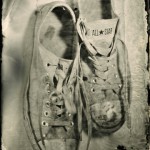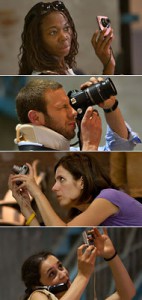Photographs, made long ago, are silent testimonies of events distant from us in time and comprehension of captured reality. Even though they are not as strange to us as paintings or narratives they still are veiled from us by inability of technology to deliver clear, sharp, and color evidence. That is why we desperately try to restore old pictures, enhance theirs appearance, add color to make them appear more suitable for our perception of reality.
Well… if humans were only rational, without emotional attachments and requirements, that would be the only way to utilize old photographs. We are not! Sometimes we desire understanding of things on emotional level. We have quantified each time period by our emotional response and contributed to it different aspects of the time; old, grainy, reddish and cracked photo associated in my psyche to a time period when I was around 8 years of age. So how can I compare myself to my son on emotional level? I can either correct the old photo of me, or make a photo of my son look old. That is precisely what Mr. Bornfriend has been doing, taking old looking pictures of soldiers and “paralleling and contrasting” them to the previous war era.
For the same reason, with the same approach, photographers and artists are giving us a chance to evaluate on emotional level new items of clothing like “Converse. Still Life” or even electronic accessories like “Old style ad for Wii” (www.flickr.com/photos/idbehold/2340968011). It is fun to see it, touching and it speaks to our “right brain”.
In my opinion (and I might not be an artist enough to make a judgement like this), making portraits as an art on its own is the only time when the old process isn’t appropriate. It might be beneficial for the photographer to go through the trouble, but surely not for a model (especially if the model or viewer has no emotional attachments to the time period in style of which the photograph was taken). Such pictures appear to me as an attempt to divert my attention from otherwise tasteless composition to the frame, from the “face of the bride to her veil”. Sam Taylor-Wood has a good deal of respect towards specific things and people of specific time period, she adores pictures of them. But then, she tries to transform there herself by making an old style pictures of herself. I sense that Sam wants to say that she doesn’t belong here, in our present, among us. Well… there might be something to it, but I don’t really see her fitting well on such photograph.





